Difference between revisions of "Language/Multiple-languages/Culture/Religions-and-Folklores:-Objects"
< Language | Multiple-languages | Culture
Jump to navigation
Jump to search
| Line 170: | Line 170: | ||
* Shintō | * Shintō | ||
|https://upload.wikimedia.org/wikipedia/commons/thumb/a/a8/Suzu_MET_DP353272.jpg/320px-Suzu_MET_DP353272.jpg | |https://upload.wikimedia.org/wikipedia/commons/thumb/a/a8/Suzu_MET_DP353272.jpg/320px-Suzu_MET_DP353272.jpg | ||
|- | |||
|khakkhara | |||
खक्खर | |||
錫杖 | |||
འཁར་གསིལ | |||
|staff used by monks | |||
| | |||
* Hàn Buddhism | |||
|https://upload.wikimedia.org/wikipedia/commons/thumb/3/3a/Sendatu01.jpg/66px-Sendatu01.jpg | |||
|- | |- | ||
|khamsa | |khamsa | ||
| Line 362: | Line 373: | ||
* Chinese folklore | * Chinese folklore | ||
|https://upload.wikimedia.org/wikipedia/commons/thumb/8/81/Pair_of_ruyi_scepters.jpg/240px-Pair_of_ruyi_scepters.jpg | |https://upload.wikimedia.org/wikipedia/commons/thumb/8/81/Pair_of_ruyi_scepters.jpg/240px-Pair_of_ruyi_scepters.jpg | ||
|- | |||
|shide | |||
紙垂 | |||
|zigzag-shaped paper streamers | |||
| | |||
* Shintō | |||
|https://upload.wikimedia.org/wikipedia/commons/thumb/4/42/Shinto_Hemp.jpg/320px-Shinto_Hemp.jpg | |||
|- | |||
|shimenawa | |||
注連縄 | |||
|laid rice straw or hemp rope used for ritual purification | |||
| | |||
* Shintō | |||
|https://upload.wikimedia.org/wikipedia/commons/thumb/a/a3/Shimenawa_-_Meiji_Shrine.jpg/320px-Shimenawa_-_Meiji_Shrine.jpg | |||
|- | |- | ||
|talít | |talít | ||
| Line 369: | Line 394: | ||
* Judaism | * Judaism | ||
|https://upload.wikimedia.org/wikipedia/commons/thumb/5/55/%D7%98%D7%9C%D7%99%D7%AA_%D7%9E%D7%A7%D7%95%D7%A4%D7%9C%D7%AA.jpg/320px-%D7%98%D7%9C%D7%99%D7%AA_%D7%9E%D7%A7%D7%95%D7%A4%D7%9C%D7%AA.jpg | |https://upload.wikimedia.org/wikipedia/commons/thumb/5/55/%D7%98%D7%9C%D7%99%D7%AA_%D7%9E%D7%A7%D7%95%D7%A4%D7%9C%D7%AA.jpg/320px-%D7%98%D7%9C%D7%99%D7%AA_%D7%9E%D7%A7%D7%95%D7%A4%D7%9C%D7%AA.jpg | ||
|- | |||
|tamaguchi | |||
玉串 | |||
|decorated sakaki-tree branch as an offering | |||
| | |||
* Shintō | |||
|https://upload.wikimedia.org/wikipedia/commons/thumb/b/bb/Tamagushi_on_an_an.jpg/320px-Tamagushi_on_an_an.jpg | |||
|- | |- | ||
|tchitcherik sakwa | |tchitcherik sakwa | ||
Revision as of 17:46, 17 July 2024

| Beings | Concepts | Events | Figures | Locations | Objects | Practices |
Generic
| object | description | religion/folklore | image |
|---|---|---|---|
| agimat
agimat |
amulet |
|

|
| asabikeshiinh
asabikeshiinh |
amulet of protective spiderweb for the children |
|

|
| aspergillum
aspergillum |
liturgical implement used to sprinkle holy water |
|

|
| daruma
達磨 |
talisman that returns to an upright position after being pushed, modeled after Bodhidharma; symbol of perseverance and resilience |
|

|
| dharmachakra
धर्मचक्र 法輪 ཆོས་ཀྱི་འཁོར་ལོ་ ธรรมจักร |
symbol of Buddhism; originally farming tool and weapon |
|

|
| ध्वज
dhvaja 幢 རྒྱལ་མཚན |
banner made with cloth, stone, or metal |
|

|
| ema
絵馬 |
wooden plaques for writing wishes |
|

|
| fúlù
符籙 |
talismanic slip |
|

|
| fūrin
風鈴 |
talisman of wind chimes |
|

|
| ghaṇṭā
घण्टा 犍稚 དྲིལ་བུ་ |
bell |
|

|
| gorgóneion
γοργόνειον |
amulet showing Gorgon head |
|

|
| goshikimaku
五色幕 |
curtains with five colours representing the Five Tathāgatas |
|

|
| gri-gug
གྲི་གུག་ |
ritual flaying knife |
|

|
| horseshoe | talisman; originally used for protecting horse hoofs |
|

|
| hù
笏 |
ritual scepter; originally used by officials as tablet for recording notes and orders |
|

|
| jangseung
長栍 |
totem pole |
|

|
| japamālā, mālā
जपमाला, माला 念珠 |
prayer beads |
|

|
| jīnchán
金蟾 |
toad figurine that brings good fortune |
|

|
| kagura suzu
神楽鈴 |
bells on a stuff used in kagura dances |
|
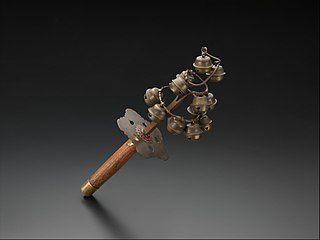
|
| khakkhara
खक्खर 錫杖 འཁར་གསིལ |
staff used by monks |
|

|
| khamsa
חמסה
خمسة
|
amulet against the evil eye |
|
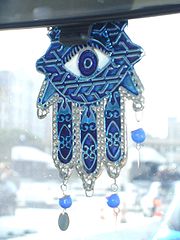
|
| 'khor lo
འཁོར་ལོ། |
prayer wheel |
|
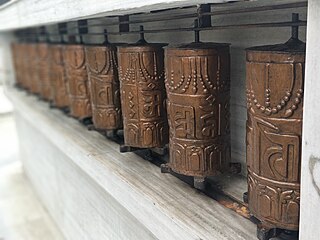
|
| khorugv
хорѫгꙑ хоругвь chorągiew |
banner |
|

|
| kirpan
ਕਿਰਪਾਨ |
single-edged curved knife that is part of the religious uniform |
|

|
| kúpellon
κύπελλον calix |
footed cup for ceremonies |
|

|
| misbaḥa, subḥa
مِسْبَحَة، سُبْحَة
|
prayer beads |
|

|
| maneki-neko
招き猫 |
cat figurine with a swaying arm that brings good fortune |
|

|
| mənōrā
מְנוֹרָהdiv>
|
symbol of Judaism; seven-branched candelabrum |
|
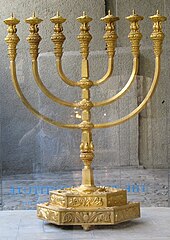
|
| मूर्ति
mūrti |
devotional image |
|

|
| naẓar
نَظَر
|
amulet against the evil eye |
|

|
| nkisi | object that a spirit inhabits |
|

|
| ofuda
御札 |
talismanic slip |
|

|
| omamori
御守 |
amulet |
|

|
| okiagari-kobōshi
起き上がり小法師 |
amulet that returns to an upright position after being pushed; symbol of perseverance and resilience |
|

|
| ōnusa, taima
大幣 |
wooden wand for ritual purification |
|

|
| ọpọ́n Ifá
ọpọ́n Ifá |
divination tray |
|

|
| ovoo, oboo
ᠣᠪᠤᠭᠠ
овоо |
shrine |
|

|
| pātra
पात्र 缽多羅 |
alms bowl by monks |
|

|
| phrakhrueang
พระเครื่อง |
amulet |
|

|
| puxís
πυξίς pyxis |
container to carry the Eucharist |
|

|
| qìng
磬 |
inverted bell as a musical instrument |
|

|
| rewe, kemukemu
rewe, kemukemu |
sacred altar |
|

|
| rlung-rta
རླུང་རྟ་ |
prayer flags with five colours representing the Five Tathāgatas |
|

|
| rosarium
rosarium |
prayer beads |
|

|
| rúyì
如意 |
ceremonial scepter (Hàn Buddhism); talisman symbolising power and good fortune (Chinese folklore) |
|

|
| shide
紙垂 |
zigzag-shaped paper streamers |
|

|
| shimenawa
注連縄 |
laid rice straw or hemp rope used for ritual purification |
|

|
| talít
טַלִּית
|
prayer shawl |
|

|
| tamaguchi
玉串 |
decorated sakaki-tree branch as an offering |
|

|
| tchitcherik sakwa
tchitcherik sakwa |
statue of ancestors |
|

|
| teru teru bōzu
てるてる坊主 |
doll that brings sunny weather |
|

|
| tfilín
תְּפִלִּין / תְּפִילִּין
|
set of small black leather boxes with leather straps containing scrolls of parchment inscribed with verses from the Torah |
|

|
| turibulum
turibulum |
censer suspended from chains |
|

|
| trollkors
trollkors |
amulet |
|

|
| tsitsít
צִיצִית
ࠑࠉࠑࠉࠕ
|
ritual fringes |
|
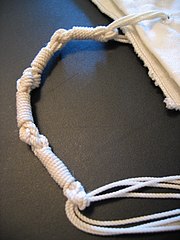
|
| tywerenge
tywerenge |
sacred wood or stone |
|

|
| rushnyk
ручник рушник |
decorative and ritual cloth |
|

|
| vájra
वज्र 金剛杵 རྡོ་རྗེ། |
ceremonial mace |
|

|
| wǔgòngjù
五供具 |
a censer, a pair of vases and a pair of candlesticks, used at an offering |
|

|
| xiānglú
香爐 |
censer |
|

|
Specific
| object | description | religion/folklore |
|---|---|---|
| Ārōn Hābrīt
אָרוֹן הָבְּרִית
|
wooden chest that contained Tablets of the Law |
|
| Excalibur | sword of King Arthur |
|
| Hama Yumi
破魔弓 |
sacred bow |
|
| Kusanagi no Tsurugi, Ame-no-Murakumo-no-Tsurugi
草薙劍、天叢雲剣 |
double-edged sword; imperial regalia |
|
| Lance of Longinus | lance that pierced the side of Jesus |
|
| Tevat Noaḥ
תֵּיבַת נֹחַ
Κιβωτός του Νώε Arca Noë سَفِينَةُ نُوحٍ
|
boat where Noah, his family and selected creatures survived a global flood |
|
| True Cross | real cross that Jesus of Nazareth was crucified on |
|
| Xuānyuánjiàn
軒轅劍 |
double-edged sword of Huángdì |
|
| Yasakani no Magatama
八尺瓊勾玉、八尺瓊曲玉、八坂瓊曲玉 |
jade; imperial regalia |
|
| Yata no Kagami
八咫鏡 |
mirror; imperial regalia |
|

| Beings | Concepts | Events | Figures | Locations | Objects | Practices |